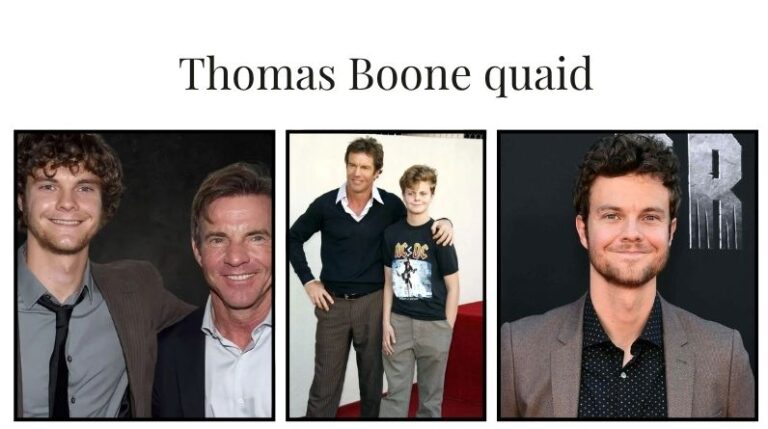When most people hear the name “Quaid,” they think of Hollywood stardom, blockbuster films, and the glitz of the entertainment industry. However, the story of Thomas Boone Quaid transcends celebrity gossip and touches on something far more profound: how a family’s personal tragedy can reshape national healthcare policies and inspire a new generation to advocate for patient safety.
Born November 8, 2007, in Santa Monica, California, Thomas Boone Quaid is the twin son of renowned actor Dennis Quaid and real estate professional Kimberly Buffington. Yet his significance extends beyond his famous lineage. His life story serves as a powerful reminder of both the fragility of newborn life and the resilience of the human spirit, combined with the transformative impact of parental advocacy.
Born Into Headlines: The Medical Crisis That Became a Catalyst for Change
The Heparin Overdose: A Turning Point in Healthcare Safety
Just days after Thomas and his fraternal twin sister Zoe Grace were born via gestational surrogacy, both infants were admitted to Cedars-Sinai Medical Center in Los Angeles for treatment of routine staph infections. What should have been standard neonatal care became a medical nightmare that would reshape hospital protocols across the nation.
On December 18, 2007, hospital staff accidentally administered a catastrophic medication error: Thomas and Zoe each received 10,000 units of heparin instead of the intended 10 units – a staggering 1,000 times the correct pediatric dose. This wasn’t a simple miscalculation; it was the result of confused labeling between pediatric and adult-concentration vials, both manufactured by Baxter Healthcare.
| Factor | Details |
| Intended Dose | 10 units (pediatric) |
| Actual Dose Administered | 10,000 units (adult concentration) |
| Overdose Multiple | 1,000 times the correct dose |
| Primary Risk | Severe internal bleeding, potential death |
| Medical Response | Emergency monitoring, blood transfusions, vitamin K |
The twins spent several harrowing days in the neonatal intensive care unit (NICU) while medical teams worked frantically to reverse the medication’s potentially fatal effects. Both infants required continuous blood testing to monitor clotting times and received vitamin K injections to counteract the blood thinner. Dennis Quaid has since described this period as “the most frightening time” of his life.
Recovery and Long-Term Impact
Miraculously, both Thomas and Zoe made complete recoveries without lasting physical complications. However, the emotional and professional impact on the family was profound. Rather than retreating from their ordeal, Dennis and Kimberly transformed their personal trauma into a catalyst for systemic change.
From Private Pain to Public Advocacy: The Quaid Foundation’s Mission
Building a Legacy Through Patient Safety Reform
Recognizing that their twins’ near-death experience could have happened to countless other families, Dennis Quaid became a vocal advocate for healthcare safety. The family’s efforts led to the establishment of The Quaid Foundation, an organization dedicated to preventing medical errors and improving patient safety protocols.
Key initiatives stemming from the Quaid family’s advocacy include:
- Improved medication labeling requirements: Clearer, more distinctive packaging to prevent confusion between pediatric and adult medications
- Enhanced staff training protocols: Better education on medication administration and double-checking procedures
- Technological improvements: Implementation of barcode scanning and computerized verification systems in hospitals
- Congressional testimony: Dennis Quaid testified before Congress about the need for stronger safety regulations
- Partnership with safety organizations: The Quaid Foundation merged with the Patient Safety Movement Foundation to amplify impact
These changes didn’t just benefit future patients – they fundamentally altered how American hospitals approach medication administration, particularly for vulnerable newborn populations. According to patient safety advocates, the increased awareness generated by the Quaids’ story has likely prevented countless medical errors nationwide.
A Tale of Two Paths: Privacy vs. Celebrity
The Deliberate Choice for a Normal Childhood
What makes Thomas Boone Quaid’s story particularly noteworthy is the conscious decision his parents made regarding his upbringing. Unlike many celebrity children who are paraded before cameras and featured on entertainment news programs, Thomas was deliberately shielded from the Hollywood spotlight.
This wasn’t accidental. Rather, it was a deliberate parenting philosophy born from both the family’s traumatic early experience and their desire to protect their children’s mental health and development. Consider the contrast:
| Aspect | Typical Celebrity Child | Thomas Boone Quaid |
| Social Media Presence | Active, frequently updated accounts | Minimal to none |
| Public Appearances | Regular red carpet events, premieres | Rare, carefully selected occasions |
| Educational Setting | Often exclusive Hollywood schools | Private schools in Austin and Los Angeles |
| Daily Lifestyle | Documented, often publicized | Private, age-appropriate activities |
| Media Interviews | Frequent participation | None |
The Psychological Benefits of Protection
Research increasingly supports the Quaids’ approach. Child development experts emphasize that excessive media exposure during formative years can lead to anxiety, identity confusion, and premature pressure to conform to public expectations. By limiting Thomas’s public exposure, his parents have afforded him something precious: the freedom to develop his own identity separate from his father’s fame.
Growing Up Quaid: Family Dynamics and Relationships
The Twin Bond: Shared Experience, Shared Strength
Thomas’s relationship with his fraternal twin sister, Zoe Grace, is perhaps his most significant family connection. The twins not only share a birthdate – November 8, 2007 – but also the extraordinary experience of surviving a life-threatening medical crisis together as infants.
This shared trauma created a bond that goes beyond typical sibling relationships. Both children grew up understanding, at some level, that they had faced mortality together and emerged victorious. This common experience likely strengthened their emotional connection and created a unique support system within the family.
A Blended Family Framework
Thomas also has an older half-brother, Jack Quaid, born in 1992 from Dennis’s marriage to actress Meg Ryan. With a 15-year age gap, Jack represents a different chapter of his father’s life and career. Notably, Jack chose to follow his father into acting, starring in films like the *Hunger Games* franchise and the television series *The Boys*.
Despite their significant age difference, the siblings maintain a positive relationship. This blended family dynamic demonstrates that successful co-parenting can create strong sibling bonds even when children are raised in different eras of their parents’ lives.
Finding His Own Path: Interests, Education, and Identity Formation
Pursuing Passions Beyond Hollywood
One of the most compelling aspects of Thomas Boone Quaid’s story is his apparent disinterest in following the entertainment industry path taken by his father and older half-brother. Instead, Thomas has cultivated his own interests:
- Music: Thomas plays guitar and engages in songwriting, sharing his father’s musical inclinations
- Photography: He pursues photography as a creative outlet
- Athletics: He participates in sports and enjoys outdoor activities
- Education: He maintains focus on his academic pursuits
This diversification of interests suggests a young man deliberately building an identity that, while informed by his family’s talents, remains distinct and independent. Unlike his half-brother Jack, who embraced his father’s profession, Thomas appears to be exploring creative fields that don’t necessarily require public exposure or celebrity status.
The Value of Choice in Child Development
Dennis and Kimberly’s parenting approach granted Thomas something many celebrity children lack: genuine choice. By not pushing him toward acting or entertainment, they allowed him to discover his own passions organically. This freedom has likely contributed to his apparent psychological stability and well-rounded development.
Key Lessons From Thomas Boone Quaid’s Journey
What His Story Teaches Us
Thomas Boone Quaid’s life offers several valuable insights applicable far beyond his celebrity family context:
- Tragedy Can Drive Change: Personal hardship, when channeled appropriately, can inspire systemic improvements that benefit society broadly
- Privacy Protects Development: Celebrity doesn’t require constant public exposure; privacy can coexist with significant family prominence
- Advocacy Without Exploitation: It’s possible to use one’s platform for social good while protecting one’s children from exploitation
- Identity Independence Matters: Children benefit when given space to develop interests separate from parental careers
- Resilience Is Taught: The Quaid twins’ survival and the family’s subsequent advocacy demonstrate resilience as both an individual trait and a family value
Current Status and Future Outlook
As of 2025, Thomas Boone Quaid is 17 years old and navigating the final years of adolescence. Unlike his childhood, when his story was dominated by the medical crisis and his parents’ advocacy, his teenage years appear focused on education, personal interests, and identity formation.
While he hasn’t publicly announced career aspirations, the possibilities remain open. Whether he continues pursuing music and photography, explores entirely different fields, or eventually enters the entertainment industry, he does so from a position of strength – surrounded by family support and freed from the obligation to follow in his father’s footsteps.
Frequently Asked Questions
Who are Thomas Boone Quaid’s parents?
Thomas Boone Quaid’s parents are actor Dennis Quaid and real estate professional Kimberly Buffington. Dennis and Kimberly were married in 2004 and divorced in 2018, but maintain active co-parenting roles.
What happened to Thomas Boone Quaid as a newborn?
Shortly after birth, Thomas and his twin sister Zoe were accidentally administered 1,000 times the correct dose of heparin at Cedars-Sinai Medical Center. Both infants made full recoveries without lasting physical complications.
Does Thomas Boone Quaid have siblings?
Yes, Thomas has a fraternal twin sister, Zoe Grace Quaid (born the same day), and an older half-brother, Jack Quaid, from his father’s previous marriage to actress Meg Ryan.
Is Thomas Boone Quaid an actor?
As of 2025, Thomas has not pursued a career in acting, despite his father and older brother both being actors. He focuses on education and personal interests in music, photography, and athletics.
What is The Quaid Foundation?
The Quaid Foundation was established by Dennis and Kimberly to advocate for patient safety and prevent medical errors. It has since merged with the Patient Safety Movement Foundation and has influenced hospital safety protocols nationwide.
Conclusion: A Life Beyond the Spotlight
Thomas Boone Quaid’s story transcends typical celebrity child narratives. While born into fame and thrust into international headlines during his first days of life, he represents something increasingly rare in modern celebrity culture: a young person allowed to develop authentically, away from the relentless glare of media scrutiny.
His survival of a potentially fatal medical error became the catalyst for healthcare reforms benefiting millions. His parents’ choice to protect his privacy set a precedent for celebrity parenting that prioritizes child welfare over publicity. As he approaches adulthood, Thomas Boone Quaid stands as a testament to resilience, the power of advocacy, and the enduring importance of family – both in moments of crisis and in the quiet, private moments that define a life well-lived.
Whether he ultimately chooses a public-facing career or maintains the privacy his family has carefully cultivated, his journey reminds us that the most meaningful legacies often extend far beyond the headlines.


